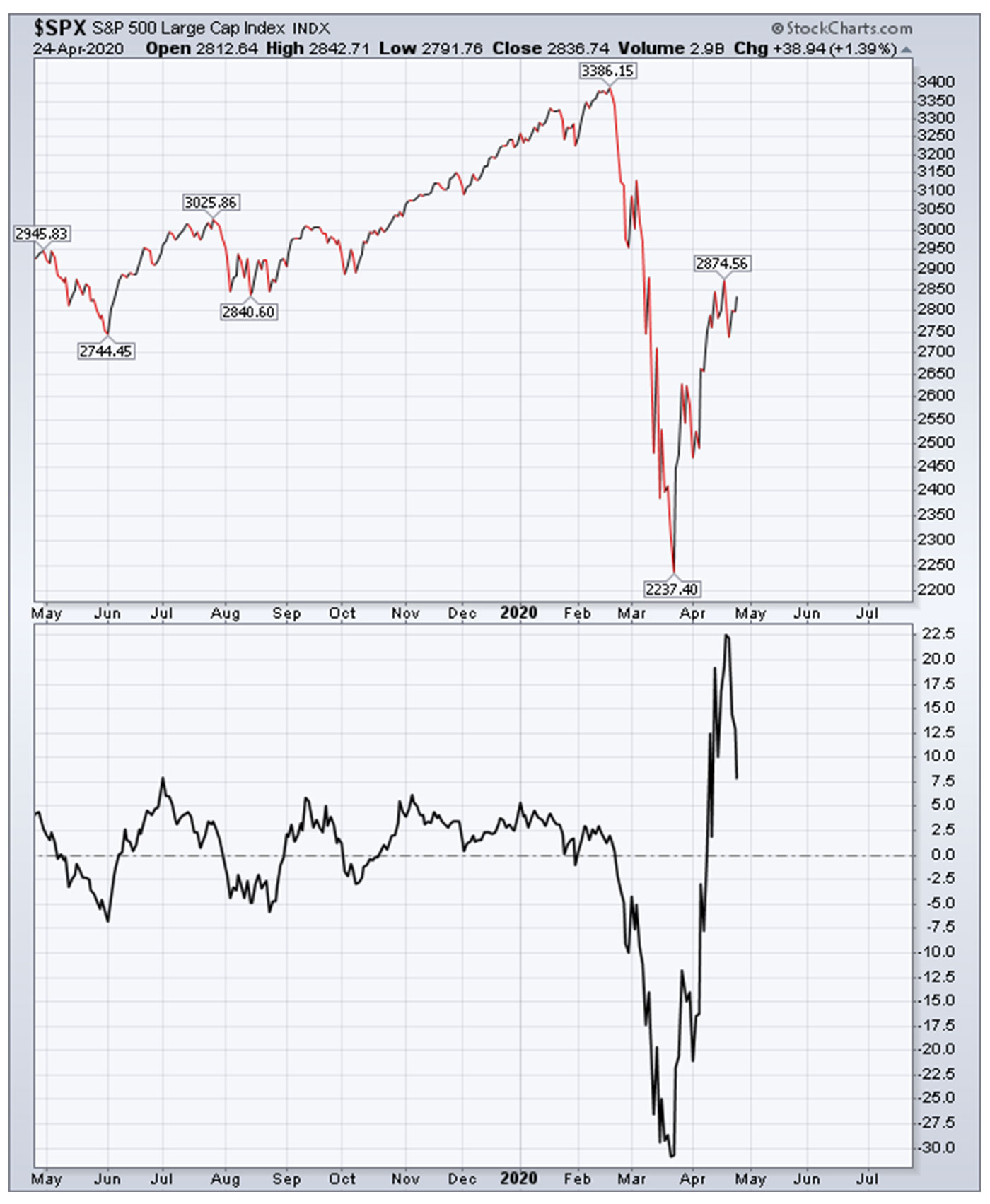Is this the greatest trick the market has ever pulled?
Is this the greatest trick the market has ever pulled?

While there is no shortage of market “experts” willing to proclaim the start of a new bull market, or those saying the bear is far from finished, financial advisors should avoid focusing on forecasts. Their most important, and difficult, task is keeping clients on track with a disciplined, long-term investment plan.
“The greatest trick the devil ever pulled was convincing the world he did not exist. And like that … he is gone.”
As I write this after the bell on Friday, April 24, the S&P 500 has gained 26.9% since March 23’s bottom at 2,191.86.
I can’t help but wonder if it’s the crash we witnessed from February’s high into March’s low or the rally we’ve now seen from March’s low that is going to be remembered as the greatest trick the market has ever pulled. Either the market tricked us into believing the bull market ended in February 2020, or the market’s now tricked us into believing the bear market ended in March.
And like that, the “bull” or “bear” is gone.
The velocity in the S&P 500’s price has been virtually unprecedented.
On a closing price basis, the Index declined 30.9% over the 20-day period from Feb. 21 through March 20, its single largest 20-day decline since 1950. The Index then gained 22.5% over the 20-day period from March 20 through April 20, its third-largest 20-day advance since 1950, only eclipsed by two 20-day stretches in April 2009. I suppose we might rewrite a common phrase to now read, “The harder they fall, the faster they rise.”
S&P 500 2020 ‘VELOCITY’—PRICE AND % CHANGE

Note: The top chart represents the S&P 500 price trend. The bottom chart represents the S&P 500’s trailing 20-day rate of change.
Source: S. Deppe, StockCharts.com market data through 4/24/2020
I believe the velocity we have witnessed is attributable to the polarizing battle that’s taking place between a major, and likely prolonged, contraction in the global economy and the unprecedented, coordinated fiscal and monetary policy response.
The global economy is still idling in neutral and rolling backward, and the fear and uncertainty regarding the coronavirus remain palpable. The S&P 500 crashed only one short month ago, credit spreads exploded as high-quality corporate bonds traded as if they were junk, oil futures traded into negative territory, and more than 30 million Americans filed unemployment claims in just six weeks. Heck, there were 700,000 jobs lost in March before we even had a recognized start date of a recession. It’s virtually certain that the job loss we experienced in April (announced the first Friday in May) will be the worst single month of job loss the country has ever seen.
The consumer’s confidence, sentiment, and balance sheet have been left for dead given the gigantic financial tsunami, so much so that it’s impossible to know just how many shoppers will be left to spend when we do reopen the economy. Some analysts are predicting the largest peak-to-trough decline in U.S. GDP since the Great Depression, or perhaps ever. To make matters worse, all of this is happening now in a seasonally favorable period of the year. What will the infamous third quarter of 2020 bring our way? Will participants have operated on the principle of “sell in May and go away”?
In the other corner, we have the collective fiscal and monetary responses to everything we just listed. Almost every central bank and government in the world has come out swinging, throwing the entire kitchen sink at the global economy. The collective fiscal and monetary response to the economic implications of COVID-19 are downright massive, and there’s no doubt that more help is on the way. The Federal Reserve has pledged “whatever it takes” and continues to expand its balance sheet to levels that were once never thought possible. Quantitative easing forever has been promised, if necessary. Fiscally, the next phase of response is already being discussed by Congress and the Trump administration. It has amounted to a few trillion here, a few trillion there, and clearly the S&P 500 likes what has been done since late March.
But one trillion-dollar question for investors is, “Which calendar month will be remembered as the liar?” Like any battle, it’s not over until it’s over, so it’s impossible at the present moment to know which side is going to prevail—bull or bear.
That’s the first main point of this article: that nobody, myself included, knows what lies ahead.
To operate as fiduciaries, we need to have an open mind about what lies ahead, since the S&P 500 will find a way to trade beyond the limits of imagination. We need a plan that predicts our behavior into the future, when we press “buy” and “sell,” rather than a plan that attempts to predict whether the upside reversal in April is a bear market rally or the start of a new bull market.
Unfortunately, there are no magical patterns, signs, signals, or indicators that can definitively tell us what the S&P 500’s returns will be for the next three to six months—or even one year from now. Nothing can tell us the maximum drawdowns and rallies that will be recorded along the way, no matter how much we all want to believe otherwise. The price action in April isn’t predictive of the price action in August. We live in unprecedented times, we’re experiencing highly volatile price action, and it’s important we conquer ourselves and find conviction in the idea that we have no idea what lies ahead. In turn, this then optimizes our ability to be dispassionate long-term investors on behalf of our clients, following a disciplined, risk-managed approach. Then and only then can we truly “trust the process.”

In one of my recent articles for Proactive Advisor Magazine, I stress the importance of behavioral adherence for long-term investors. The article centers on the idea that risk is behavioral, and that the biggest risk a long-term investor faces is not portfolio volatility, or drawdown, but the inability to adhere to their long-term investment policy during periods of portfolio volatility or drawdown. I wrote,
“There’s no better time than now to be proactive in helping our clients avoid acting upon the ‘greed’ associated with wanting to increase their allocation to the large-cap domestic-equities space. I think we need to plan for the day when the ‘fear’ of the large-cap domestic-equities space causes our clients to want to abandon their fundamental investment policy.”
We’ve now come full circle to the days where both “fear” and “greed” are leading our clients to consider abandoning their long-term investment policy. The average investor is anything but dispassionate, unfortunately.
Given the volatility across virtually all asset classes, it’s only natural for some of our clients to think that their portfolio is broken. Emotionally, it’s normal for them to feel like they had too much invested in stocks in March, and not enough invested in stocks by the end of April.
The problem is that we’re all hardwired to want to fix what’s “broken.” Not because it is truly broken but because of investors’ behavioral biases, reinforced by the constant financial and virus headlines.
The volatility in the global financial markets is tricking our clients into thinking there is something they need to be doing differently with their portfolio. Many clients are probably wondering and asking their advisor, “What should we be doing now?” It’s up to us to help them understand that what we should be doing now is probably the same thing we should have been doing three, six, and 12 months ago, as counterintuitive as it may seem.
We have to do everything we can to be proactive in managing their emotions, to help them place faith over fear, to show leadership, to not let them get fooled, and to not let the market trick us. Here are a few of the ways we’re doing that for our clients:
- Communication is key. I liken market volatility to turbulence on a plane, and there’s nothing I hate more than not hearing from the pilot during turbulent times. We’re all generally the pilot of our clients’ investment portfolios, so we must step up our communication during turbulent times. I’ve written a weekly market update every Sunday since 2008, solely to increase the communication with our clients regarding the probable path they can expect their portfolio to travel. While many would argue that this is overkill, and some of our clients don’t read it, there’s a discernable uptick in readership during turbulent times. When they need it the most, it’s there for them. The more touch points, the better.
- Emphasize the plan. No, not just the financial plan, but the plan for the ongoing management of your clients’ portfolios. Ideally, your portfolio-management process is governed by an investment policy statement (IPS). While many investment policy statements are too often dead documents (i.e., they are reviewed and then discarded), they function best as living documents. The antidote to fear, panic, and uncertainty is a prudent, intelligent, and defensible plan. If you aren’t using an IPS, you absolutely should be. If you are using an IPS, then bring your clients’ IPS back to life to help them understand that you have a plan, and there’s no better time to stick to the plan than when things veer off track. I also think it’s a great time to do a deep dive into portfolio analytics and stress testing. Illustrating to our clients a range of future outcomes their portfolios can experience will help set realistic forward-looking expectations. This then reinforces the appropriate behaviors before they reach the stage of emotional chaos.
- Control what we can control. All we can control as long-term investors is the process we choose to adhere to for the ongoing management of our portfolio, and whether we exercise discipline in trusting the process. Put more simply, we can control the risks we choose to accept, we can then diversify and manage those risks, but we can’t absolutely control the returns our portfolio experiences. There’s never a bad time to have a conversation with your clients about risk. Given the surge higher off March’s low, now is as good a time as ever to talk about the plan and the behaviors that will be necessary in the event there is a second leg down later this year.
- Embrace tactical asset allocation. In my opinion, tactical asset allocation (TAA) is all grown up. There’s enough empirical evidence to support the idea that long-term investors can diversify how they attempt to capture the equity market risk premium. A synergy is created by pairing both passive and active investing methodologies with one another. The upside since late March should not be viewed as a reason why TAA is not worthy; instead, TAA’s general success in minimizing drawdown in March is why it’s a valuable diversifier, especially when considering its psychological impact on our client’s behavioral adherence. This is an area where third-party asset managers are beyond valuable, especially with many advisors emphasizing traditional strategic asset allocation (SAA) methodologies. I like to say that the best of SAA methodologies in 2020 include an allocation toward TAA, and third-party asset managers execute TAA strategies with far more experience and discipline than a typical advisor. I am familiar with the performance of several third-party managers during the worst of March’s drawdown, and, in general, their strategies did a nice job in mitigating drawdowns.
- If it’s not broken, don’t fix it. The losses and volatility your clients’ portfolios may have experienced in March, and the gains they’ve since experienced in April, probably aren’t reasons to change long-term investment policy. Market crashes are the blind spots to virtually all prudent longer-term investing strategies. Changing long-term investment policy based on what would have worked better in the recent short term is a recipe for disaster as we look toward the future. Advisors who change long-term investing policy based on two months of unprecedented velocity across financial markets are essentially allowing the market to trick them, and that’s generally bad for business over the long term.
Putting it all together, uncertainty is the mother of volatility, both in markets and in the emotional aspect of investing. Don’t allow present-day uncertainty to trick your clients, or yourself, into thinking you’re certain about what lies ahead. Find peace in the brilliance of saying, “I don’t know”; focus all your efforts on what you can control; and help your clients stick to the process and plan they’ve entrusted you to execute.
The opinions expressed in this article are those of the author and do not necessarily represent the views of Proactive Advisor Magazine. These opinions are presented for educational purposes only.
This material is intended for industry professionals and is not intended to be relied upon as a forecast or investment advice, and does not constitute a recommendation, offer, or solicitation for any specific security or any specific investment strategy. Investment advice is only provided within the context of a written advisory agreement with a client. This material represents the current market views of the author, and there is no guarantee that any forecasts made will come to pass. Due to various risks and uncertainties, actual events, results, or performance may differ materially from those reflected or contemplated in any forward-looking statements.
 Steve Deppe, CMT, is a principal and senior market strategist and wealth advisor at Nerad + Deppe Wealth Management, based in San Diego, California. He began his career with American Express Financial Advisors and was a manager for several years with Ameriprise Financial. Mr. Deppe is a CMT (Chartered Market Technician) charterholder and a member of the CMT Association. He is also a member of the American Association of Professional Technical Analysts (AAPTA).
Steve Deppe, CMT, is a principal and senior market strategist and wealth advisor at Nerad + Deppe Wealth Management, based in San Diego, California. He began his career with American Express Financial Advisors and was a manager for several years with Ameriprise Financial. Mr. Deppe is a CMT (Chartered Market Technician) charterholder and a member of the CMT Association. He is also a member of the American Association of Professional Technical Analysts (AAPTA).
